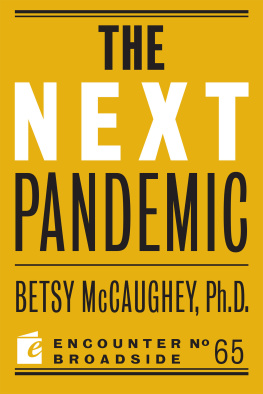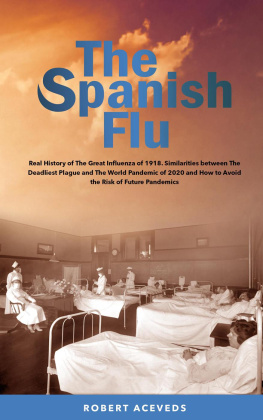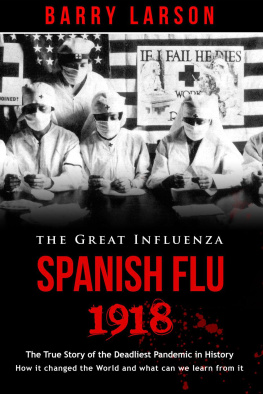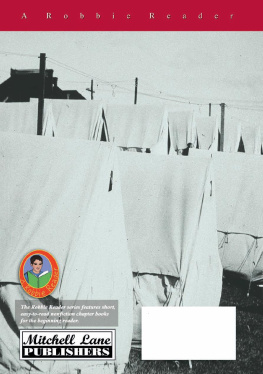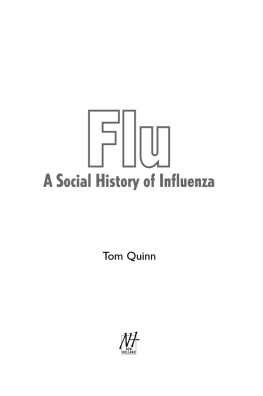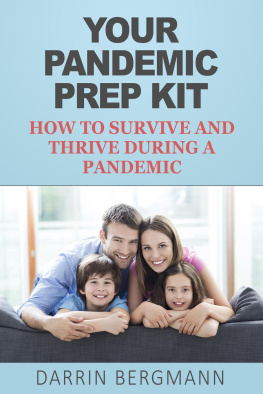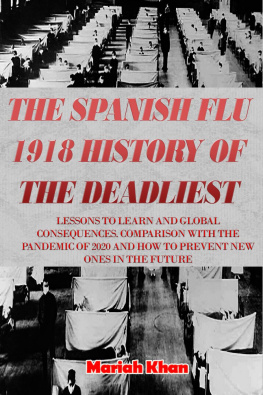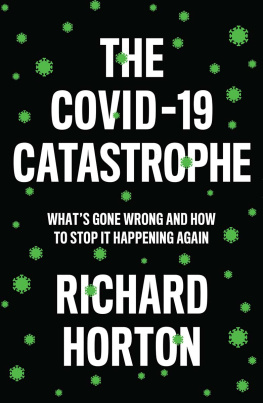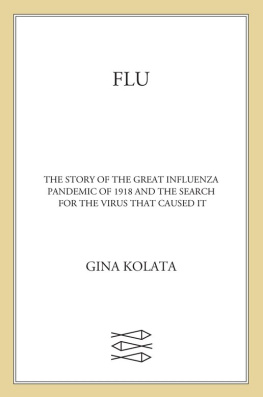for Tim and Jenny
About the Author
Pete Davies is the author of of a number of critically acclaimed, best-selling works of non-fiction including ALL PLAYED OUT, I LOST MY HEART TO THE BELLES and THIS ENGLAND. He lives in West Yorkshire.
Pete Davies
CATCHING COLD
1918s forgotten tragedy and the scientific hunt for the virus that caused it

PENGUIN BOOKS
UK | USA | Canada | Ireland | Australia
India | New Zealand | South Africa
Penguin Books is part of the Penguin Random House group of companies whose addresses can be found at global.penguinrandomhouse.com.

First published 1999
Copyright Pete Davies, 1999
The moral right of the author has been asserted
All rights reserved.
ISBN: 978-0-241-47855-4
This ebook is copyright material and must not be copied, reproduced, transferred, distributed, leased, licensed or publicly performed or used in any way except as specifically permitted in writing by the publishers, as allowed under the terms and conditions under which it was purchased or as strictly permitted by applicable copyright law. Any unauthorized distribution or use of this text may be a direct infringement of the authors and publishers rights and those responsible may be liable in law accordingly.
Acknowledgements
I am grateful to Rowland White for having the idea in the first place, and for the deft editorial touch he deployed to rein me in whenever I got too excitable. As ever, thanks also to my agent Rachel Calder, and to all at Tessa Sayle.
Dr William Liddell and Dr Rob Brett were kind enough to read the manuscript, making many pertinent comments, and correcting me on matters medical and molecular wherever necessary. Both also answered my numerous questions, as did Drs Jane Smith and Steve Johl. Any errors that may remain are mine alone.
I am grateful above all to the many scientists and public health officials involved in this story in England, Holland, Hong Kong, Canada, the United States and elsewhere-many of whom gave me considerable amounts of their hard-pressed time. I doubt theyll all like the end-product, or agree entirely with everything in it, but if they did they wouldnt be scientists. I hope, however, that theyll believe it to be a fair and accurate account of a complex, fascinating and vitally important subject that deserves a lot more public attention than it normally gets.
Finally, thanks as always to Rebecca, Joe and Megan for tolerating so patiently my too-frequent absences.

1. The Incident in Hong Kong
Hong Kongs Central Market is on Queens Road, a few minutes walk from the hub of the Territorys capital around Statue Square and the Star Ferry Pier. On three floors of a nondescript grey building youll find clothing, fruit and vegetables, meat, fish and chickens. These last two are sold on the ground floor, from separate aisles of concrete stalls under a tangle of strip-lights and ventilation ducts.
For all the Territorys hectic modernity, most Chinese still view fresh food as one of lifes essentials, and many shop for it daily before they go to work. As a result, when I got to the market at nine-thirty one morning in June 1998, much of the days business was already done. Seafood live crabs, tuna steaks, king prawns and slinky eels still lay on beds of ice; on the other aisle, however, the chicken merchants were packing up.
Birds jostled and squawked, crammed tight in cages made of metal or plastic. Plucked and gutted for restaurants, others floated in wooden tubs, tied in bunches at the neck or feet with lengths of reed. The tile floor was sopping wet where it had been washed down, and here and there lay greasy piles of red and yellow entrails. Even packing up, the place was vivid to the senses but youll not find any poultry market in Hong Kong as vibrant today as they were until the last days of 1997.
Before then youd have found chickens, ducks, geese, quail, pigeons and pheasants squeezed higgledy-piggledy together in wooden cages in a honking mayhem of beak and feather. Among those birds in 1997, however, a virus load was building up that led to one of the most frightening outbreaks of disease this century, carrying within it the potential to kill millions upon millions of people.
The first sign of trouble came in March 1997, when chickens started dying on a farm near Yuen Long, in Hong Kongs rural New Territories. On a second farm, and then a third, they started dying in droves in all, nearly 7,000 birds succumbed and the disease that was killing them was flu.
When a pathogenic strain of influenza takes hold in chickens, its an ugly business. The virus spreads through the bloodstream to infect every tissue and organ; the brain, stomach, lungs and eyes all leak blood in a body-wide haemorrhage until, from the tips of their combs to the claws on their feet, the birds literally melt. During an outbreak in Pennsylvania in 1983, as birds keeled over and died within a couple of days of contracting the infection, one researcher described them as being reduced to bloody Jell-O.
Apart from being thoroughly unpleasant, for the farmers involved its economically disastrous. To put an end to it in Pennsylvania, the US Department of Agriculture eventually had to slaughter some twenty million chickens. In the spring of 1997, therefore, the agricultural authorities in Hong Kong took the only possible course of action; on the farms affected, every bird not already dead was destroyed. Not that many were left; the disease was so bad that on two of the three farms, it had killed virtually every bird already.
The virus responsible was isolated by Hong Kongs Department of Agriculture and Fisheries, and passed to Kennedy Shortridge for identification. Fifty-seven years old, Shortridge is a tall, bluff, cheerful Queenslander whod been in Hong Kong for twenty-five years; now Chair Professor of Microbiology at the Territorys University, hed been studying multifarious strains of flu in birds and animals nearly all the time hed been there. When he saw what this strain was, however, he decided straight away that he wasnt going near it.
There are countless types of flu virus; some are harmless, others are lethal, but either way theyre characterized according to the nature of two proteins on their outer skin. One, called haemagglutinin, is shaped like a spike; the other, neuraminidase, looks like a long-stemmed mushroom. To date, flu strains with fifteen different forms of haemagglutinin have been found, and with nine different variants of neuraminidase so viruses are labelled H1N1, H2N2, and so forth.
The new Hong Kong virus was an H5N1 and virologists know that when an H5 turns nasty in chickens, it can turn very nasty indeed. To handle it, therefore, you need containment conditions involving an appropriately high level of bio-security. Ken Shortridges lab is housed in the Universitys Pathology Building, part of the Queen Mary Hospital compound at Pok Fu Lam, overlooking the western approaches into Victoria Harbour; in due course, the events of 1997 in Hong Kong would see the facilities there significantly upgraded. In the spring, however, Shortridge readily accepted that they werent sufficiently secure. The last thing I wanted, he says, was for this virus to escape.
Next page


